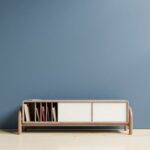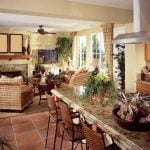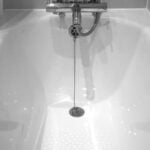It is often said that a picture is worth a thousand words, and this couldn’t be truer when it comes to home decor. Photographing your carefully curated living spaces can not only capture the essence of your personal style but also serve as a source of inspiration for others. Whether you are an interior designer looking to showcase your work or simply a homeowner wanting to document your interior transformations, knowing how to photograph home decor is essential.
Photographing home decor allows you to share your passion and creativity with the world in a visually appealing way. It provides an opportunity to tell a story through the placement of objects, colors, and textures. The right photograph can transform a simple room into a stunning masterpiece, evoking emotions and inspiring others.
Furthermore, capturing images of your home decor can be incredibly useful from a practical standpoint. It allows you to see your space from different angles and perspectives, enabling you to identify areas that may need improvement or rearrangement. Additionally, having high-quality photos of your home decor opens up possibilities for sharing on social media platforms, attracting potential clients or collaborators.
In this article, we will explore the various aspects of photographing home decor. From essential equipment needed to setting up the perfect backdrop and understanding lighting techniques, we will provide you with all the tips and tricks necessary for capturing stunning shots of your living spaces. So grab your camera and get ready to elevate the beauty of your home through photography.
Equipment needed for photographing home decor
To capture stunning home decor photos, you will need the right equipment. The following are essential items for photographing home decor: cameras, lenses, tripod, and lighting.
Firstly, a high-quality camera is crucial for obtaining sharp and detailed images. Consider investing in a DSLR or mirrorless camera that offers manual control over settings such as aperture, shutter speed, and ISO. These options will give you more flexibility and allow for greater creativity when capturing your home decor.
In addition to a camera, selecting the right lens is important. A wide-angle lens with a focal length between 16mm and 35mm is ideal for capturing entire rooms or larger pieces of furniture. This type of lens will enable you to showcase the spaciousness and layout of the space effectively.
Next, having a sturdy tripod is essential for achieving stability and avoiding blurry images. It keeps your camera steady during longer exposures or when shooting in low-light conditions. A tripod also allows you to compose your shots precisely and make adjustments without any movement.
Lastly, lighting plays a critical role in home decor photography. While natural light is often preferred due to its softness and authenticity, it is not always available or sufficient. Investing in artificial lighting equipment such as studio lights or continuous LED panels can help supplement or control the lighting in your photoshoots. Consider using diffusers or reflectors to soften harsh light sources and create a more pleasing effect on your subjects.
| Equipment | Description |
|---|---|
| Camera | A high-quality DSLR or mirrorless camera with manual control |
| Lens | A wide-angle lens with a focal length of 16mm to 35mm |
| Tripod | A sturdy tripod for stability and precise composition |
| Lighting | Natural light, studio lights, or continuous LED panels with diffusers or reflectors |
Setting up the perfect backdrop for your home decor photos
Setting up the perfect backdrop for your home decor photos plays a crucial role in capturing stunning and visually appealing images. The right location, props, and lighting can make a significant difference in showcasing the beauty of your home decor. Here are some tips to help you set up the perfect backdrop for your home decor photos.
Choosing the right location is essential when photographing home decor. Look for areas with ample natural light, such as near windows or doors, as this will provide soft and flattering lighting for your subjects. Avoid spaces with harsh artificial lighting or too much direct sunlight, as it can create unflattering shadows or wash out colors. Consider the overall aesthetic of the room and choose a location that complements and enhances the decor you’re trying to capture.
Arranging props strategically can add interest and dimension to your home decor photos. Choose pieces that complement the main subject but don’t overpower it. Props can include items like flowers, books, candles, or decorative accents that tie in with the theme or style of the decor you’re photographing. Experiment with different arrangements and compositions to find what works best for highlighting the key elements of your shot.
While choosing the right location and arranging props are important components of setting up a perfect backdrop for your home decor photos, lighting also deserves careful consideration. Lighting can make or break a photo, so take time to analyze how different sources of light affect your composition. Natural light is often preferred for its softness and flattering qualities but be mindful of any shadows it may create.
Artificial lights can be used creatively to add drama or emphasize certain aspects of your decor. Consider using diffusers or reflectors to soften harsh light sources or bounce light onto specific areas for more control over lighting conditions.
Taking these factors into account while setting up your backdrop will help you create visually compelling images that showcase the beauty of your home decor. Pay attention to details such as location selection, prop arrangement, and thoughtful lighting choices to capture the essence of your home decor in a captivating and aesthetically pleasing way.
Lighting techniques for capturing stunning home decor shots
Lighting plays a crucial role in capturing stunning home decor shots. The choice between natural light and artificial light can greatly impact the mood and overall quality of your photographs. Understanding how to manipulate and diffuse light effectively can help you create beautiful images that showcase the beauty of your home decor.
When it comes to lighting for home decor photography, natural light is often preferred. It offers a soft and flattering illumination that can enhance the textures, colors, and details of your subjects. To take advantage of natural light, position your subject near a window or in a well-lit area of your home. Avoid direct sunlight as it can create harsh shadows and overexposure. Instead, look for soft, diffused light coming through curtains or blinds.
On the other hand, artificial lighting can offer more control over the intensity and direction of light. Using artificial lights such as strobes or continuous lights allows you to adjust the position, angle, and power of the lighting to achieve the desired effect. This can be particularly useful when shooting in low-light environments or when you want to create a specific atmosphere in your photos.
To soften harsh lighting from both natural and artificial sources, using diffusers is essential. Diffusers act like filters that scatter or spread out the light, creating a softer illumination with less contrast. There are various options for diffusing light, including specialized diffuser panels, umbrellas, or even white bed sheets or curtains. Place these materials between the light source and your subject to achieve a more pleasing and even lighting effect.
Composition tips for capturing the beauty of home decor
Composition tips are essential for capturing the beauty of home decor in photographs. By following certain guidelines, you can create visually pleasing and engaging images that highlight the best features of your home decor. In this section, we will explore three composition techniques: the rule of thirds, leading lines, and framing objects.
The rule of thirds is a fundamental principle of composition in photography. According to this guideline, you divide your image into a grid of nine equal parts by imagining two horizontal and two vertical lines.
The idea is to place points of interest along these lines or at their intersections, which creates a more balanced and visually appealing composition. When photographing home decor, consider aligning key elements such as furniture or decorative items along these grid lines to create a pleasing visual flow.
Leading lines are another powerful compositional tool that can guide the viewer’s attention towards the focal point of your image. These lines can be actual physical lines within your home decor, such as the edges of furniture or architectural details.
Alternatively, they can be implied lines created by the arrangement of objects or patterns in your composition. By strategically incorporating leading lines in your photographs, you can create a sense of depth and draw the viewer’s gaze towards specific areas within your frame.
Framing objects is another technique that can enhance the visual impact of your home decor photographs. By using elements within your environment to frame your subject, you add depth and dimension to your composition. This could include using door frames, windowsills, or even other decorative pieces as natural frames around your main subject. Framing adds context and helps to focus attention on the subject while adding an extra layer of visual interest to your photos.
Incorporating these composition tips into your home decor photography will help you capture stunning images that showcase the beauty and essence of each piece. Experiment with different angles and perspectives to find what works best for each item or space you are photographing.
| Composition Technique | Description |
|---|---|
| Rule of Thirds | A principle that divides an image into nine equal parts with two horizontal and two vertical lines to place points of interest along these lines or at their intersections |
| Leading Lines | Lines that guide the viewer’s attention towards the focal point of the image, whether they are actual physical lines or implied lines created by the arrangement of objects or patterns |
| Framing Objects | Using elements within the environment, such as door frames or windowsills, to create natural frames around the main subject and add depth and visual interest to the composition |
Styling home decor for the camera
Arranging objects
When styling home decor for the camera, it’s essential to arrange the objects in a visually appealing and balanced way. Consider the colors, shapes, and sizes of the items you want to showcase. Experiment with different placement options until you find a composition that is pleasing to the eye.
One technique is to group similar items together. For example, if you’re photographing a collection of vases, arrange them in a cluster or line. This helps create a sense of cohesion and organization in your shot.
Another approach is to create layers or depth in your composition. Place larger objects in the foreground and smaller ones in the background to add visual interest. This can also help draw the viewer’s eye into the photo and guide their gaze through the scene.
Creating visual interest
To capture stunning home decor photos, it’s important to generate visual interest within your composition. One way to do this is by incorporating various textures and patterns into your shots. Mix smooth surfaces with rough ones, such as pairing a sleek vase with a textured table runner.
Additionally, consider using contrasting colors to make certain elements stand out. For example, if you have a neutral-colored wall, place vibrant or bold-colored decor items against it for an eye-catching effect.
Don’t be afraid to experiment with angles and perspectives as well. Capture shots from different heights and viewpoints to add variety and intrigue to your images. Play around with shooting from above, below, or at an angle for unique compositions.
Avoiding clutter
When photographing home decor, it’s crucial to minimize clutter in order to keep the focus on the main subject. Remove any unnecessary or distracting items from the frame before taking your shot.
Remember that less is often more when it comes to styling home decor for photography. A cluttered shot can be overwhelming and take away from the beauty of the individual pieces. Instead, select a few key items and arrange them intentionally to showcase their uniqueness.
Additionally, pay attention to negative space and breatheability in your composition. Leaving some empty areas in your photo can help create balance and allow the viewer’s eye to rest on the main subject without feeling overwhelmed.
By arranging objects thoughtfully, creating visual interest, and avoiding clutter in your home decor photos, you’ll be able to capture the essence of each piece beautifully and create compelling images that draw viewers in.
Mastering camera settings for home decor photography
Mastering camera settings is essential for capturing stunning home decor photographs. The right combination of aperture, shutter speed, and ISO can make a significant difference in the quality of your images. Let’s delve into each of these settings and understand how they contribute to creating visually appealing home decor photos.
Aperture
Aperture refers to the size of the opening in the camera lens through which light passes. It is measured in f-stops and controls two crucial elements: depth of field and exposure.
To capture intricate details of home decor objects, a larger aperture (smaller f-stop number) like f/2.8 or f/4 is ideal as it allows more light to enter and creates a shallow depth of field. This will help draw attention to specific elements while blurring the background.
Shutter Speed
Shutter speed determines how long the camera’s sensor is exposed to light. It plays a crucial role in capturing sharp images, especially when photographing home decor where you want every detail to be crisp and clear. Generally, using a tripod is recommended for interior photography as it allows for longer exposure times without introducing camera shake. Experiment with different shutter speeds and find the balance between freezing motion (faster speeds) and capturing enough light (slower speeds).
ISO
ISO determines the sensitivity of your camera’s sensor to light. Increasing the ISO can make your camera more sensitive, allowing you to shoot in low-light conditions without adding artificial lighting; however, it also adds digital noise or graininess to your images. Aim for the lowest possible ISO setting (e.g., ISO 100 or 200) for cleaner shots with less noise, especially when shooting with ample natural light or using additional lighting equipment.
Remember that mastering these settings takes practice, so don’t be afraid to experiment and adjust them according to the specific lighting conditions and creative vision for your home decor photographs. As you gain experience, you’ll develop an intuition for which settings work best in different situations, allowing you to capture the essence of home decor through photography.
Editing and enhancing home decor photos
Editing and Enhancing Home Decor Photos: Using Software Tools to Enhance Colors, Adjust Exposure, Remove Distractions
Once you have captured your home decor photos, the next step is to edit and enhance them using software tools. Editing can take your photos from good to great, enhancing the colors and adjusting the exposure to make them look their best. Additionally, you can remove any distractions that may take away from the beauty of your home decor.
One of the most popular software tools for editing photos is Adobe Photoshop. With Photoshop, you can easily adjust the colors in your image using tools like Curves and Levels. By fine-tuning the color balance, saturation, and contrast, you can make your home decor photos appear more vibrant and eye-catching.
Another important aspect of editing home decor photos is adjusting the exposure. Sometimes, due to lighting conditions or camera settings, your photos may be too bright or too dark. Software tools like Adobe Lightroom allow you to easily fix this by adjusting the exposure settings. You can bring out details in darker areas without losing details in brighter areas.
In addition to color and exposure adjustments, it’s often necessary to remove distractions from your home decor photos. This could include removing unwanted objects or blemishes that take away from the overall composition. In Photoshop, you can use various retouching tools like the Clone Stamp or Healing Brush to seamlessly remove these distractions.
Overall, editing and enhancing your home decor photos allows you to showcase the true beauty of your subjects. By using software tools like Adobe Photoshop and Lightroom, you can bring out the colors, adjust the exposure, and remove distractions for stunning results. Additionally, experimenting with different editing techniques will help you develop a unique style that sets your home decor photography apart from others.
Software Tools for Editing Home Decor Photos
- Adobe Photoshop: An industry-standard photo editing software with advanced features for color adjustment and retouching.
- Adobe Lightroom: A powerful editing tool specifically designed for photographers, with easy-to-use adjustments for exposure and other enhancements.
- GIMP (GNU Image Manipulation Program): A free alternative to Photoshop with similar features for editing and enhancing photos.
Enhancing Colors and Exposure
- Use tools like Curves and Levels to fine-tune the color balance, saturation, and contrast in your home decor photos.
- Adjust the exposure settings to bring out details in darker areas without losing details in brighter areas.
Removing Distractions
- Utilize retouching tools like the Clone Stamp or Healing Brush to seamlessly remove unwanted objects or blemishes from your home decor photos.
Showcasing your home decor photos
Creating a Portfolio
Once you have captured stunning home decor photos, it’s important to compile them into a portfolio that showcases your work and demonstrates your skills to potential clients. A well-curated portfolio will not only impress viewers but also give them an idea of your style and creative vision. Here are some tips on how to create an effective portfolio for your home decor photography:
Choose Your Best Shots
Selecting the best photos for your portfolio is crucial in making a strong first impression. Take the time to carefully go through your collection and choose images that are visually striking, showcase different styles or themes, and highlight the variety of home decor you’ve photographed. Aim for a cohesive flow throughout your portfolio, ensuring that each photo complements the others.
Create an Online Presence
In this digital age, having an online presence is essential for reaching a wider audience. Create a website or utilize social media platforms to showcase your home decor photos. Keep in mind that potential clients may be searching specifically for photographers who specialize in home decor, so make sure to optimize your online presence with relevant keywords and descriptions.
Sharing on Social Media
One of the most effective ways to promote your home decor photography is through social media platforms. Instagram, Pinterest, and Facebook are popular choices for showcasing visually appealing images and connecting with potential clients who appreciate aesthetics.
Utilize Hashtags
Hashtags play a crucial role in helping users discover specific content related to their interests. Research popular hashtags relevant to home decor photography such as #homestyling, #interiorphotography, or #homedecorinspo. By including these hashtags in your captions and comments, you increase the visibility of your work among people browsing those categories.
Attracting Clients
To attract potential clients interested in hiring you as their home decor photographer, it’s important to market yourself effectively:
Collaborate with Influencers and Brands
Reaching out to interior designers, home decor brands, and influencers can expose your work to a larger audience and potentially lead to collaborations. Offer your services for free or discounted rates in exchange for exposure on their platforms.
Attend Home Decor Events
Networking is a valuable tool in the photography industry. Attend home decor events such as trade shows, exhibitions, or local meetups where you can connect with potential clients face-to-face. Be prepared to share samples of your work and business cards for follow-ups.
By effectively showcasing your home decor photos, utilizing social media platforms, and implementing marketing strategies, you increase your chances of attracting clients who appreciate your unique perspective on capturing the essence of home decor through photography.
Conclusion
In conclusion, learning how to photograph home decor is a valuable skill that allows you to capture and showcase the essence of your interior design. By following the steps outlined in this article, you can create stunning images that highlight the beauty of your home decor.
Having the right equipment is essential for achieving professional-looking results. Investing in a quality camera, lenses, tripod, and lighting will greatly enhance the quality of your photographs. Additionally, setting up the perfect backdrop and considering lighting techniques will help create a visually appealing composition.
Composition plays a crucial role in capturing the beauty of home decor. Remembering to follow guidelines such as the rule of thirds, leading lines, and framing objects will make your photos more aesthetically pleasing. Styling and arranging your home decor for the camera is equally important. By creating visual interest and avoiding clutter, you can ensure that your subject takes center stage.
Mastering camera settings, such as aperture, shutter speed, and ISO, is also key in achieving professional-looking photographs. Understanding how these settings affect exposure and depth of field will allow you to have full control over the final outcome of your images.
Once you have captured your home decor photos, editing and enhancing them using software tools can further elevate their quality. Enhancing colors, adjusting exposure, and removing distractions are just some ways to improve the overall appearance of your photographs.
Finally, showcasing your work is essential for attracting clients or simply sharing your passion with others. Creating a portfolio that showcases your best shots and sharing them on social media platforms can help gain exposure for your photography skills.
Overall, by applying these techniques and tips outlined in this article, you can capture the essence of home decor through photography. Whether it’s for personal enjoyment or professional purposes, mastering this skill will allow you to appreciate and share the beauty of interior design with others.
Frequently Asked Questions
How do you take professional home decor pictures?
Taking professional home decor pictures requires attention to detail and a focus on capturing the essence and beauty of the space. Start by decluttering and cleaning the area to ensure a visually appealing backdrop. Consider the lighting in the room – natural light is often preferable for showcasing interior designs, but if necessary, use artificial lighting to enhance certain areas.
Set up the scene by arranging furniture and decor in an aesthetically pleasing manner, keeping in mind balance, symmetry, and focal points. Experiment with different angles to find the best perspective that showcases the room’s unique features. Lastly, edit your photos using photo editing software to enhance colors and remove any imperfections.
How do you take good pictures of a house room?
To take good pictures of a house room, it’s important to consider composition, lighting, and perspective. Begin by decluttering and organizing the space so that it looks neat and visually appealing. Take into account the room’s purpose and highlight its best features when selecting what elements to include in the frame. Pay attention to lighting – natural light often works best as it creates a warm ambiance and brings out details effectively.
Experiment with different angles to find one that captures the room’s dimensions and offers an inviting view. Avoid using extreme wide-angle lenses that may distort proportions unnaturally. Lastly, post-processing can be used sparingly to enhance colors or make minor adjustments.
How do you take pictures of interiors?
Taking pictures of interiors requires attention to detail and careful planning to capture spaces accurately yet artistically. Begin by removing any distractions or clutter from the scene as much as possible – this could involve rearranging furniture or hiding personal items temporarily.
Good lighting is essential; utilize natural light whenever possible by opening curtains or blinds but aim for diffused lighting avoid harsh shadows or overexposed areas. Consider using a tripod or stabilizing equipment depending on available light or your desired depth of field – this help maximizes image sharpness while allowing for longer exposure times if needed.

I’m thrilled to be your companion on this exciting journey through the world of home decor and design. With a passion for turning houses into homes and a keen eye for the finer details, I’m here to help you transform your living spaces into beautiful, functional, and meaningful havens.





